 |
Faith under Attack
Trick-or-Treat: A Trick to Divert
Attention from All Souls’ Day
Margaret Galitzin
Since today is the Feast of the Holy Souls, let me address some correspondence we received on the topic. A reader informed me that several of the TIA articles [here and here] on Halloween had sparked a controversy among his friends. One man agreed with our position. Others argued that abandoning the Halloween custom of trick-or-treating or haunted houses was “just too extreme.” It is only simple fun and games, nothing dangerous or evil, they argued. Our correspondent believed he had found a middle ground, “the perfect solution,” a counsel he believed we would find very sensible.
“My take is this,” he wrote. “You need to do what you feel is right concerning this ‘holiday.’ I know as a child, before all the evil connotations were affiliated with the day, we enjoyed dressing up and going out to gather treats. We were not drawn to Satanism or Paganism and were not drawn away from our faith because of it. It was just a fun evening for children.
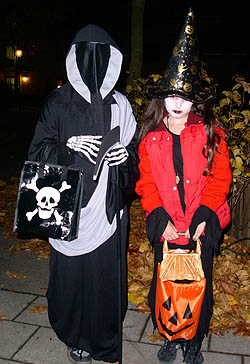
Trick or treating - nothing but good fun? |
“The next day we went to Church and that was part of the whole 2 or 3 days then. I see today there is a fast-growing tendency to hawk the dark side of Halloween, plus the problems with pedophiles, tampered-with treats and the like, making it difficult to decide whether your children should participate. We should be careful, however, not to demonize something that may have Catholic roots.”
His mediatory arguments can be reduced to three:
- You may rely on what you feel is the right thing to do.
- We can continue to let children trick-or-treat today because we did it when we were children.
- We should not condemn customs that can have Catholic roots.
I do not agree with this supposedly reasonable approach to Halloween or the arguments justifying it. I will explain my opinion.
Feelings vs. principles
Because of the escalating influence of the cultural revolution on modern minds, American Catholics also have the tendency to rely on feelings rather than principles. If something “feels” right, then it must be right. The Catholic, however, should have recourse first to principles in resolving questions like the ones posed above: Are these American Halloween customs good? Are they based on Catholic traditions? Are they approved by the Church?
Traditionalist Catholics are becoming stronger and more influential by the day, and more and more families want to return to good customs and eschew revolutionary ones. Even in matters considered small or trivial, they don't want to cede on principles in order to accomodate mainstream social feelings.
‘Since we did it as children, it’s good’
The second argument also is reduced to a type of sentimental thinking. Actually, many of our past customs were strongly influenced by the liberal Protestant spirit, often adopted by us out of human respect. A simple example: To “fit in” many Catholics stopped making the Sign of the Cross before eating their meals in public places or before saying their prayers in buses or planes.
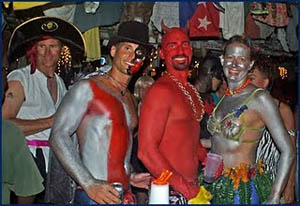
Adults in macabre and often immoral costumes at Halloween parties everywhere
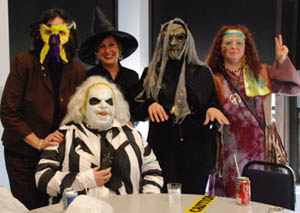 |
Another censurable compromise was for the children of European Catholic immigrants to fraternize with Protestants and call them “Christians” in order to move up in society. Again, to show that Catholics were “good Americans,” the parochial schools - long before the Council - taught that the revolutionary principles of liberty, equality and fraternity represented progress, despite Church teaching and papal warnings to the contrary. In the cultural sphere, Catholic women followed the fads, donning their bathing suits and shorts for sports outings already in the 1950s.
All of these were wrong things we accepted when we were children and now - thanks to a better counter-revolutionary formation - we are rejecting them. Thus we see that to accept what we did in “good old days” as a pattern of good doctrine is not always secure.
The excuse “It didn’t hurt us” should not be used by any Catholic as a justification to continue following the wrong path.
Present day counter-revolutionary Catholics want to eschew every compromise of the Faith or concession to bad customs in secular society. We are willing to abandon all habits and practices that further the revolutionary spirit. This is why we are re-examining the “American holiday” of Halloween.
No Catholic roots
In fact, the Halloween customs of trick-or-treating, haunted houses, fortune telling and dressing as witches do not have Catholic roots.
As demonstrated in other articles, the roots of Halloween lie in an ancient Celtic-Druid pagan festival in the United Kingdom, Ireland and northwestern France. The pagan Celts believed that on that night, the boundary between the worlds of the living and dead blurred and the ghosts of the dead returned to the earth. It was a night for preternatural communication with the dead, various forms of divination, prophecy and ritual orgies. Even the “custom” of dressing as witches and demons finds its roots here: The village people donned such costumes to “fool” the real demons and the damned who returned to earth on that night to drag the living down into Hell with them.
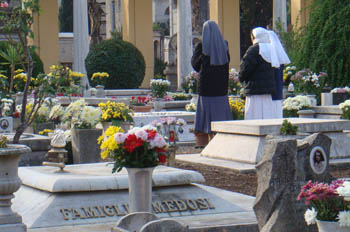
Above, the Catholic custom of praying for the dead at cemeteries; below, today it is becoming common to find phony cemeteries in yards
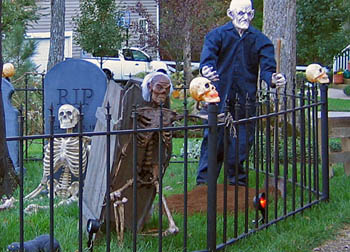 |
In the 9th century, the Catholic Church exorcized that pagan celebration by establishing the feasts of All Souls Day and All Saints Day. Throughout Catholic Europe and the Americas, these feast days were celebrated by Catholics and good wholesome customs were introduced to honor the Blessed in Heaven and to pray for the Poor Souls in Purgatory. They were – and still should be – days of recollection that have an atmosphere of calm joy and lively hope respectively for all those who already enjoy the beatific vision or are still in Purgatory
What many Americans do not realize is that until recently, no one is Spain, Portugal and Italy, Poland, Hungary and Austria, or Brazil, Argentina and Chile went “trick-or-treating” or followed the secular Halloween customs. To the contrary, it was ignored or viewed as a kind of American barbarism. “Halloween never existed for us when I was growing up,” a French friend told me. “We associated it with America, with children dressing up in lurid costumes, who then go trick or treating - a custom I first encountered when I visited the US.”
Only recently has “the American holiday” been adopted among some extravagant avant-garde circles in large cities of Europe and South America, with adults dressing up and children trick or treating instead of celebrating the traditional Catholic feast days.
Secular roots of trick or treating
To justify trick or treating, some Catholics pretend it originated in the Middle Ages with a practice known as “guising.” Actually, this was a late medieval custom that existed only in some parts of England and Ireland. Beggars would go from door to door asking for food on All Souls’ Day. So, prayers for the souls of the departed were “exchanged” for what were called soul cakes. This, however, was neither a general custom in medieval Europe nor was there ever any threat made should the household not provide the alms.
In colonial America, instead of praying for the dead, the Puritans and Protestants had harvest parties that were held on All Souls Day to deviate attention from the Catholic religious feast days that they so vigorously rejected. It also became a night for mischief and pranks, which the youth would make and then blame on devils and ghosts. Here we already see a revival of the old pagan legends and rites. Town papers in the 1800s would lament the antics of the “wild youth” who tipped outhouses and let cows run loose on Main Street.
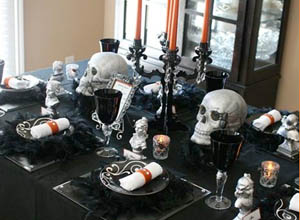
Today's elaborate macabre decor for Halloween dinners |
By the 1920s and 1930s, such pranks were turning into vandalism, property damage and even physical assaults in the larger cities. To curb such activity, Protestant community groups and Masonic lodges began to encourage the "trick or treat" visits to deviate youth from engaging in their increasingly deviant pranks. This solution served the dual purpose of sabotaging the Catholic commemoration of All Souls Day and preventing the rowdy youth from vandalizing the cities. This, then, is the origin of our modern “trick or treat” custom of children and youth going door to door asking for candy.
By the 1970s, trick-or-tricking had simply become an opportunity for children to dress up as ghosts and witches to get as much candy as possible. Clearly, the roots of our present day trick-or-treating are not Catholic.
As noted in other articles, the modern Halloween has assumed other connotations much more ominous than the trick-or-treat of the past. Today’s Halloween atmosphere is infused with paganism, immorality and even outright Satanism. Thus it seems to me a very good moment for Catholics to turn their backs on this American holiday and return full emphasis to the holy feast days honoring the Saints and Poor Souls on November 1st and 2nd.

Posted on November 2, 2007

Related Topics of Interest
 Halloween - A Return to Paganism Halloween - A Return to Paganism
 What’s Good and Evil about Halloween? What’s Good and Evil about Halloween?
 Secret Spells Barbie and the Tendential Revolution Secret Spells Barbie and the Tendential Revolution
 Satanism on the Rise Satanism on the Rise
 The Subtle Invasion of Satanism The Subtle Invasion of Satanism
 Satanism in the Man's Domain Satanism in the Man's Domain
 Harry Potter and the Problem of Good and Evil Harry Potter and the Problem of Good and Evil


|
Faith under Attack | Religious | Home | Books | CDs | Search | Contact Us | Donate

© 2002-
Tradition in Action, Inc. All Rights Reserved
|
 |
|